For a recent research project I had chosen to investigate the increasing pollution in the perimeter of the Republic of China. I am in an on-going evaluation how China is dealing with it’s ecological concerns, and the article “China’s Sustainable Fashion Paradox” introduced a new perspective into my analysis. Just as Kostadinova stresses that “One of the main criticisms towards green consumerism is that it exacerbates the problem of overconsumption by reducing consumers’ guilt as they feel they are taking some pro-environmental action”(230); it suggests that the methodology of informing /or raising awareness/ to the general public has not reached its potential peak as so many still do not understand the concept of sustainability. Alternatively, those who do understand don’t necessarily contribute, which to an extent is an even larger issue than ignorance. Comprehending that ‘sustainability’ is not just a ‘reduction in the intensity of consumption'(231) is an essential step in overcoming this first obstacle. It is also interesting to consider that the first step towards problem solving becomes an obstacle later down the line, or at least something that needs altering. I am really involved in understanding Design Thinking, as I see its application to be very universal in targeting options for concerns as large as the ecology. Through gaining understanding, I am able to move towards ‘action’ in my behaviour, which is not the most common response to knowledge these days. This raises questions: Why do I feel this way? How could more people be involved in the initial phases of research and consideration?
W4: “Cradle to Cradle Design” – Eva
As I began reading Designing for the Circular Economy: Cradle to Cradle Design, I was once again reminded of the fundamental question we covered in class “Can we do more good, instead of focusing on doing less bad?” I found it interesting that Puma, in order of achieving the Cradle to Cradle module, had to make adjustments not only on the micro scale but also the macro infrastructure. This chapter included a lot of questions for consideration, which made me want to look at the tags on my clothes. I realised that almost all of my clothes would be considered to be made out of technical nutrients instead of biological. I then called my grandmother to ask her about her shopping choices. She explained that her clothing is not necessarily bought with the intent of being sustainable, but living in the outskirts of Lithuania and having access to Mugės (like a pop up market ever so often) – she has the exposure to locally made biological nutrient conscious choices. She had explained how most of her winter clothes are 100% cotton, which I found interesting noting that the price she mentioned seemed very little. So than I had examples of different kind of clothing (from a VERY small sample of myself, and y grandmother), which made me look at the difference in our wardrobes. My focus was on colours, patters, and wacky designs, while she prioritised the basic need of warmth and comfort. Bottom line was that I was still paying more money for pieces which were not only very bad for the environment, but also were going to be used for less than two years (at best). I am absorbing a lot of information, and day by day am trying to impliment this knowledge into practice, because just as this chapter highlighted – we have so many choices, we choose to do nothing – and I do not want to be a part of this mass mentality anymore.
Recitation 3. Sensors by Eva
Instructor: Marcela
Partner: Alison
For this recitation we wanted to explore the Infrared Distance Sensor as well as the Vibration Sensor.
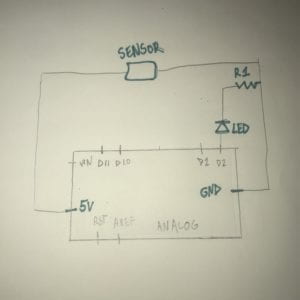
Infrared Distance Sensor
We started by taking the needed materials out of our new boxes, this included: jumper cables, the Breadboard, the Arduino, an LED. We connected the circuit, and began to write our code. We had set the parameters of 5 cm, this meant that once the sensor detected at the range >5cm, the LED would turn on. As we prototyped, we developed some interesting ideas how this could work practically. For example, our prototype could be implemented as a light for the key hole. Once the key is close enough to the keyhole, the led would light the keyhole for easier access. Maybe that is just something I struggle with in the dark, but it was fun to think about the usage of our creation.
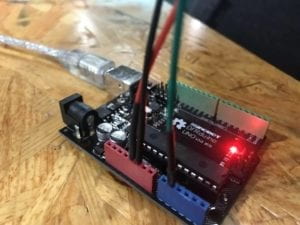
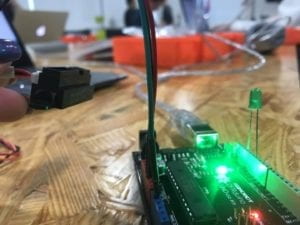
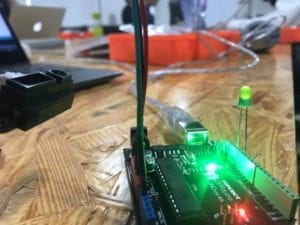
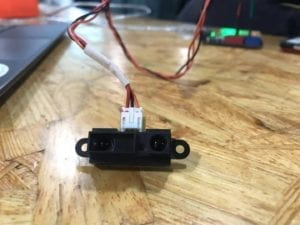
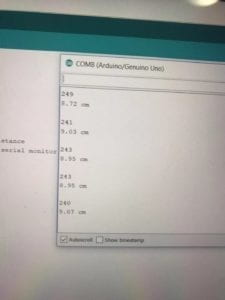
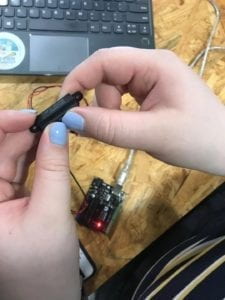
Vibration Sensor
As we finished the first circuit, we also really wanted to test the Vibration Sensor. The piezo disk sensed pressure, and we instructed the Arduino code to activate the LED once it get the input from the sensor. As we had created the first complete and working circuit, this task was more simple to follow.
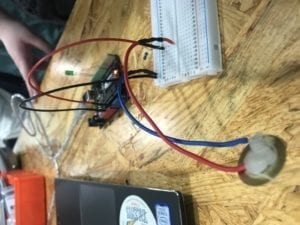
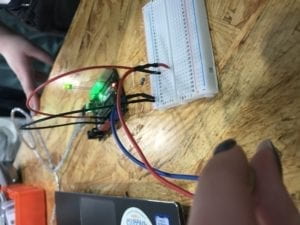
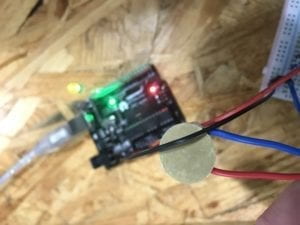
Questions
Q1 (part 1 under Infrared Distance Sensor), as for the Vibration Sensor: I once again am thinking of safety precessions. Say the door handle would have such a sensor implemented in it – it would just be able to provide light the moment you enter a room, but it would also warn you if someone else is. I reference the living situation, because as a student living at dorm, I know privacy is greatly appreciated, so when I was developing the circuits I kept referring back to how great it would be to have such utilities accessible when I consider my future living situation.
Q2 Code is often compared to a recipe or instructions because it provides the knowledge for the technology to execute the directions. I am really glad I am able to start understanding digital communication, through code, as I notice these coding techniques are helping me consider my own life in an orderly fashion. It must be so precise, and a single error might end the operation – it allowed me to prioritise not only my tasks, but also make lists of values and how they relate to the ‘environment’ I am in.
Q3 I am currently in Interactive Machine Learning, and I would actually like to develop this question from the knowledge I gained in that course. So after I began learning the basics of communicating with technology, I realised that human behaviour patterns and the models we program – at its core had the same logistics. (I was thinking how imageClassification() and impressions of people before you actually know them relate). So when we consider how the computer influences human behaviour, we have to remember that we built the computing system based on our perception. The technology is an extension tool of a human, to help and aid us for efficiency and convenience. The world today very heavily relies on technology for any and all global affairs. Also just as I described above, understanding how code works, for me personally, allowed me to lay out my thoughts (also this wasn’t conscious, I just noticed how subliminally I was subcategorising tasks, and how they branched out, some related, others proceeding independently).
W3: “The Story of Eileen Fisher” – Eva
As I read Eileen Fisher’s story, I was being bombarded with insights I was not yet aware of about the production of fabrics to the final product. The mention of chlorine rinsing for the preparation of wool really stood out to me. The process of taking this step out is not as much complicated, as uncommon. As I read, I was developing the idea on supply and demand. The current issue is that consumers demand what the producers put in front of them, and then I thought: What if we, collectively, demanded for awareness? {“This was basically aimed at providing the necessary information to everyone in order to make the best decisions for the company and its suppliers.”} Awareness in terms of knowing how and why the manufacturing is proceeding. With the ability to understand, maybe people would demand what EF is building from scratch. The 2020 Vision of the company sounds very inspiring, and could be displayed as a role model for many more brands. It also entails the extent of care it takes to truly consider something to be sustainable. The story of Eileen Fisher displays how empathy, knowledge, and dedication should look like when we reference Fashion production.
W3: Fabric Market Trip Report -Eva
ZINE:
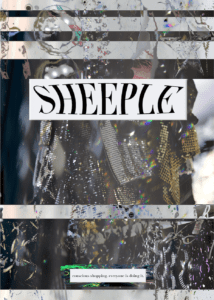
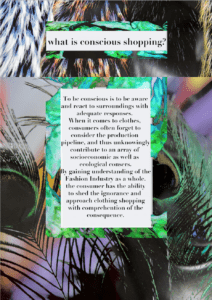
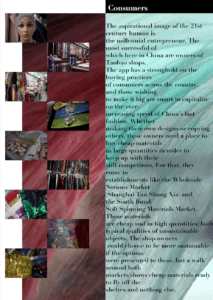
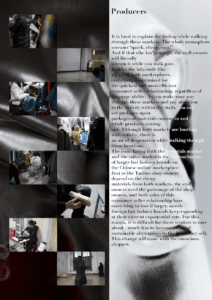
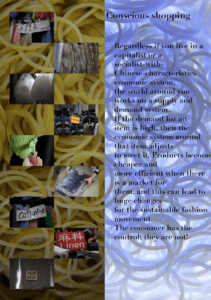
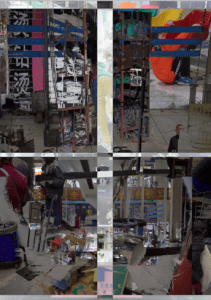
VIDEO:
During our field trip, we decided to do non-participatory observation study to investigate the clothing production pipeline from the perspective of local vendors in Shanghai.
The ZINE is a ‘fashion’ inspired magazine style series that gives a brief overview of our experience at the two Shanghai Fabric Markets. The influence of True Cost is noted, because the whole day we were conducting our observations we repeatedly referenced the documentary. Through the size, we wanted to attract the viewers – thus choosing the aesthetics to be appealing to someone interested in style and clothing shopping past the basic need. We targeted this audience for the precise reason of informing them about conscious shopping. As I was editing the visual references, I often took myself as an example (past me/ prior to learning the information form this course) – this allowed me to explore the most efficient ways of raising awareness. The information I am absorbing through these practices is really resonating with me, and I would hope this wave spreads on, thus brining me to the video influence.
I am a big fan of watching Youtube, I could even go as far as to say – a big percentage of my daily consumed information comes from this platform. Acknowledging how influential these influencers are to me, I wanted to role play and experiment with the technique of raising awareness through empathy. I wanted to video to feel very personal, as if I am talking to “my audience” as they were my friends. Through this I was able to express my feelings, as well as add visual aid from the 800 photo album we collected during our observations. Reflecting now, I could have approached this part of the assignment a little bit differently: talking through our study the way we conduced it. The issue with this is that no one past our class would be interested in seeing something as such, and I really do feel passionate about these topics – especially the ecology issues – therefore my mindset with the assignments go beyond getting points on a rubric. This plays a big part in our final project development on conscious consumption.